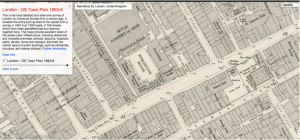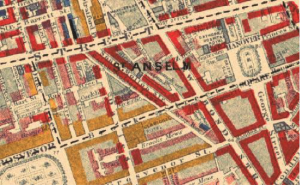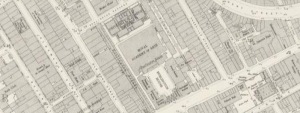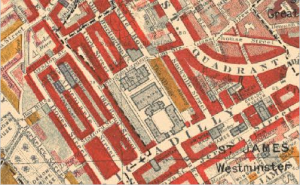In Chapter 9 of The Romance of A Shop, Bond Street is mentioned in relation to Sidney Darrell, an influential artist at the Royal Academy. The Royal Academy was a society in Victorian London dedicated to the arts and improving on previous artistic styles. The fact that the sisters are at the Royal Academy in this chapter is a main plot point as it shows the kind of people they have connections to, and how their business may be about to take off.
The sisters grew up in comfortable, I guessed high middle class, surroundings. When their father dies they are forced to come up with a new way to support themselves and they decide to open up their own photography studio. Many of the other characters object to this occupation as suitable for young women, but they do it anyway. I was somewhat surprised when they settled on Baker Street because I already knew from our last exercise that it was in a fairly wealthy part of London, and the sisters seemed to not have much money between the four of them. However, one of the other characters notes that they have to pay up in order to succeed and attract the right kind of loyal cliental among all the other photography studios. Many locations are mentioned several times throughout the first nine chapters, but Bond Street is only mentioned once as being the location of Darrell’s gallery; my book notes that it is an “area of fashionable shops and galleries (114). Looking at the Charles Booth poverty map confirmed that Bond Street was an area for the upper class:
There wasn’t that much information available on Bond Street other than that it was a mostly commercial area near the Royal Academy and that it was split into “New Bond Street” and “Old Bond Street.” I actually found more information on it in the introductory materials in the front of the book, one being from a chronology of Amy Levy’s life. In 1887, “The University Club for Ladies opens in New Bond Street.” A little more flipping through this introductory material found that Amy Levy was an early member of the club and wrote an essay on women’s clubs as an “established fact of the contemporary cityscape, and as a meeting-ground for old and young, intellectual and fashionable, traditional and modern women” (25). Having the four sisters in the book around people who have their business in Bond Street, I think, is a nod to the progressive part of society that Amy Levy was trying to advocate and push for and shows what kind of people the sisters are. They are new women, Fanny a little more begrudgingly, and they want to have their own stake in the world even if everyone tells them that they shouldn’t, that they’re not allowed. Bond Street is mentioned once so far but it’s a strong statement for Amy Levy to make that women would be known as professionals in that area of Victorian London.
Levy, Amy. The Romance of a Shop. Broadview Press, 2006. Print.
The Charles Booth Online Archive. October 28, 2015. Web.




